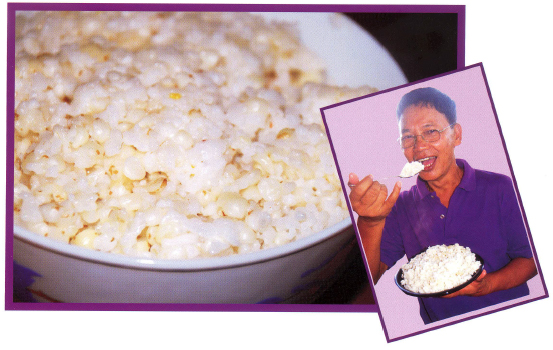Standing tall in the wild, adlai (Coix lacryma-jobi L.) can be easily overlooked due to its grass-like appearance that blends well with the other wild plants. But unlike weeds, the stem of adlai could grow from 1 to 3 meters tall (from 3 to nearly 10 feet). It bears tear-like shape grains which become the source of (staple) food of many indigenous people particularly in the highlands.

Adlai belongs to the family Poaceae or the grasses, the same family to which wheat, corn, and rice belong. It produces good yield in areas where rice and corn hardly grow like the highlands. Adlai can tolerate low pH, poor soil quality, waterlogging and is resistant to pests
Just like its counterparts (rice, corn), Adlai is highly nutritious. It is because of this that the Deparment of Agriculture (DA) is promoting Adlai as a staple crop which may well solve the country’s chronic insufficiency as far as palay is concerned.
To further promote Adlai as a staple crop, the Bureau of Agricultural Research (BAR), as the focal RDE agency tasked to look into the potential of this crop, has been conducting 11 adaptability trials (station and on-farm) of adlai varieties for seed production and commercialization.
Dr. Nicomedes P. Eleazar, director of BAR, explained that “adaptability trials have been established in different parts of the country basically to assess the performance of different adlai varieties in different locations and elevations. The results will be beneficial for the farmers who want to grow this crop in a commercial range as well as for the agriculture industry given our current challenge for rice sufficiency.”
Adlai is as versatile as rice
Just like rice, farmers grow Adlai as their staple crop for its good eating quality. Adlai bears tear-shape grains which when matured are harvested, pounded, threshed, and winnowed, cooked and served steamed just like rice.
“It looks and tastes like rice, only the grains are a bit larger, mas matagal magutom kapag kumakain kami ng Adlai (it takes time to feel hungry when we eat Adlai),” said one of the locals from Malaybalay, Bukidnon when they were invited to try the cooked Adlai during lunch.
For those who have tried cooking Adlai, they mentioned that “Adlai takes a bit more time to cook due to the size of the grains.” Testimonies of those who have tried cooked adlai during a taste-test conducted by BAR also showed that, “Compared to white corn grits, the cooked Adlai grains is softer in texture and more compact.”
As food source, Adlai is as versatile as rice. It can be cooked and processed as main ingredient for the all-time rice-based kakanin such as maja blanca, sinukmani, champorado, polvoron, and turones de adlai to name a few.
It has a pleasant mild flavor making it a good ingredient in soups and broths. The grain can be ground into flour and used to make breads, pastas, and porridge. The pounded kernel is also made into a sweet dish by frying and coating with sugar. It can also be husked and eaten as it is just like peanuts.
A tea can be made from the parched seeds while beers and wines are made from its fermented grains. Coffee or tea is made from the roasted seed.
Nutritive value of Adlai
Eating 100 grams per serving of adlai, one is less likely to feel hungry after awhile compared to eating rice or corn. This is because adlai has the highest food energy content (356 kcal) compared to corn, white rice or brown rice. Hence, a person who ate a cup of steamed adlai for lunch is build to last a whole day’s work compared to those who ate rice.
Adlai is also superior to its staple counterparts when it comes to carbohydrate content (73.9 g), protein (12.8 g), and fat (1.0 g).
| Nutritive Value | Adlai** | White Corn Grits* | Brown Rice*** | White Rice*** |
| Energy (kcal) | 356 | 135 | 129 | 110 |
| Carbohydrates (g) | 73.9 | 24.6 | 27.9 | 22.9 |
| Protein (g) | 12.8 | 2.6 | 2.7 | 2.6 |
| Fat (g) | 1.0 | 0.7 | 0.3 | 0.9 |
| Dietary Fiber (g) | 0.3 | 0.7 | 0.4 | 1.8 |
* Nutrition facts of White Corn Grits (IPB Var 6) released by Crop Science Cluster-Institute of Plant Breeding, UPLB
** Nutrition facts of Adlai Grits released by Food and Nutrition Research Institute (FNRI) chemical analysis, 2011
***Nutrition facts of White and Brown Rice released by FatSecret All Things Food and Diet (www.fatsecret.com)
According to the International Office of Cocoa Chocolate and Confectionery (IOCC), the primary nutritional role of carbohydrates (whether sugars or starches) is to provide energy. This energy is constantly needed by the body to maintain life.
For developing countries like the Philippines, 70-80 percent of a person’s calorie intake should be in the form of carbohydrates. The kind of carbohydrate consumed could affect the quality of health of the person. And considering the amount of carbohydrate content in every 100 gram serving of cooked adlai, this could help in feeding the increasing population of the country, even more, lessen the need for rice importation.
Adlai is also packed with other minerals including calcium (25 mg), phosphorus (43.5 mg), iron (5 mg), niacin (4.3 mg), thiamine (0.28 mg), and riboflavin (0.19 mg). #
References:
1. IOCCC. (1995). Nutritional Factsheets: Sugars. (http://www.caobisco.com/doc_uploads/nutritional_factsheets/sugars.pdf)
2. DA-BAR. 2011. Adlai: Traditional Staple Food Crop.
3. DA-BAR. 2011. Adlai Recipes.
4. DA-NOMIARC. 2011. Adlai Production Guide.
By: Rita T. dela Cruz, BAR Digest October-December 2011 Issue (Vol. 13 No. 4)


saan po pwedeng makabile ng adlai sa metro manila?
swan po pedeng makabile ng adlai sa metro manila?